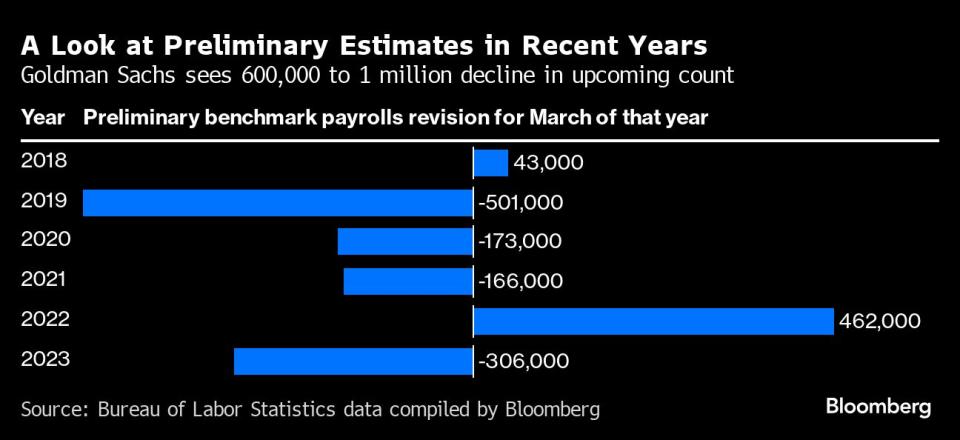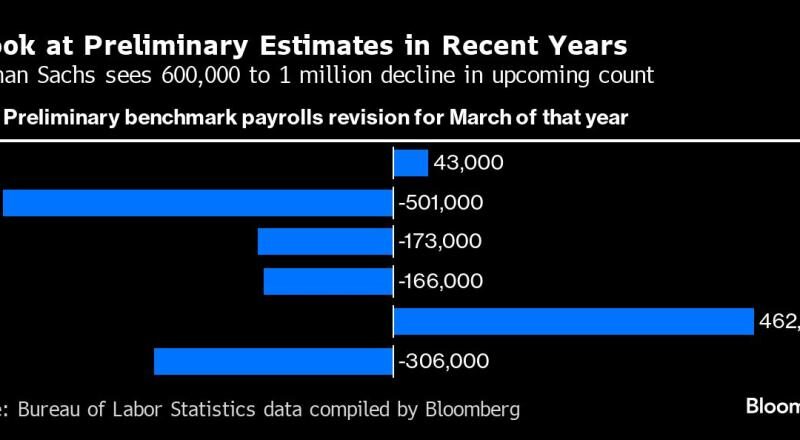The Fed is facing up to a million US jobs that will disappear in the future
(Bloomberg) — U.S. job growth in the year to March may have been much weaker than previously thought, a risk that is fueling concerns that the Federal Reserve is slowing cutting interest rates.
Most Read from Bloomberg
Goldman Sachs Group Inc. and Wells Fargo & Co. economists. They expect the government’s first update on Wednesday to show wage growth in the year to March was 600,000 weaker than currently estimated – about 50,000 per month.
Although experts at JPMorgan Chase & Co. see a decline of about 360,000, Goldman Sachs suggests it could be as large as a million.


There are a few caveats in the initial numbers, but the lower employment survey of more than 501,000 would be the largest in 15 years and suggest that the labor market has been cooling for a long time. – and perhaps even more – than was originally thought. The final numbers should appear early next year.
Such numbers also have the potential to change the tone of Fed Chair Jerome Powell’s speech later in the week in Jackson Hole, Wyoming. Investors are trying to gain insight into when and by how much the central bank will start lowering interest rates as inflation and the labor market cool.


“A significant negative change would indicate that hiring power was already declining prior to last April,” Wells Fargo economists Sarah House and Aubrey Woessner said in a note last week. That could make “risks on the absolute side of the Fed’s jobs even stronger amid widespread easing in other labor market data.”
Once a year, the BLS reports the March wage level to a more accurate but outdated data source called the Quarterly Census of Employment and Wages, which is based on unemployment insurance tax returns and covers the almost all jobs in the US. The release of the latest QCEW report in June has already shown a slight increase in wages over the past year.
As it stands now, BLS data shows the economy added 2.9 million jobs in the 12 months through March 2024, or an average of 242,000 per month. While the full assessment is about a million, monthly job gains are about 158,000 — still a healthy hiring pace but measured from the post-pandemic peak.
Omair Sharif, president of Inflation Insights LLC, is optimistic that the update will end up at the small end of estimates, in part because the QCEW data tends to be marked higher due to reporting delays. .
Occupational hazards
The first version may rekindle the debate about whether a downturn in the labor market could pose the risk of a major recession. Employers fell sharply in July and the unemployment rate rose for the fourth month in a row. While that contributed $6.4 trillion to the world’s stock market, the S&P 500 (^GSPC) has fully recovered.
“Markets, fresh from growth scares that have led to concerns that the Fed is backing down, will be checking Wednesday’s release of benchmark updates to see if the market’s initial reaction was correct, ” said Quincy Krosby, head. global strategist at LPL Financial.
Although some employment indicators have reassured the markets that the job market is in a solid state, policymakers are still expected to start reducing borrowing costs in September.
Powell and his colleagues recently said they are focusing more on the labor side of their dual mandate, and he will consider benchmark updates in his speech Friday at the Fed’s annual meeting.
“Although Wednesday’s earnings update has been long-awaited by the Fed, this will create an atmosphere and will emphasize that the picture of the ability to pay is not as strong as it appeared in real time, ” Evercore ISI analysts Krishna Guha and Marco. Casiraghi said in a letter Monday.
The government’s main budget will be followed by final assessments included in the January jobs report that will be released in February.
A model of birth-death
In recent years, monthly earnings data have been stronger than QCEW figures. Some economists say that part of the so-called birth-death pattern — an adjustment the BLS makes to the data to account for the total number of businesses opening and closing — but that may not be true. off in the post-pandemic world.
What Bloomberg Economics Says…
Since the Bureau of Labor Statistics’ ‘fertility model’ is overestimating employment from the creation of new firms, we assume that the average monthly growth rate of job growth is less than 100k – below the pace corresponding to the steady rate of unemployment. We expect the unemployment rate to reach 4.5% by the end of the year. ”
—Anna Wong, Stuart Paul, Eliza Winger and Estelle Ou
Ronnie Walker of Goldman Sachs said the QCEW numbers may overstate the job growth rate because they will miss out on the half a million illegal immigrants that were included in the original estimates.
“Since the QCEW relies on unemployment insurance claims, it may not include unauthorized immigrants, who we believe have contributed strongly to job growth over the past several years,” Walker wrote last week.
Best Reads from Bloomberg Businessweek
©2024 Bloomberg LP
#Fed #facing #million #jobs #disappear #future

